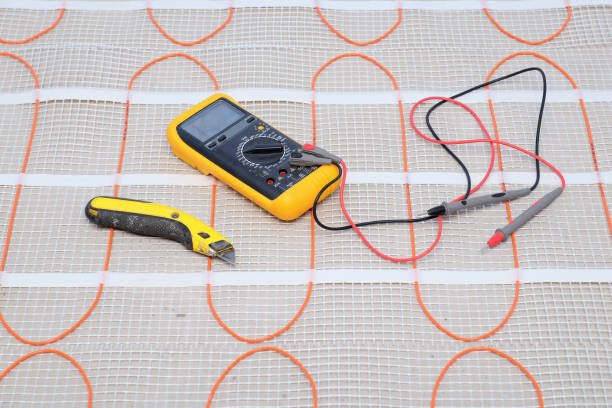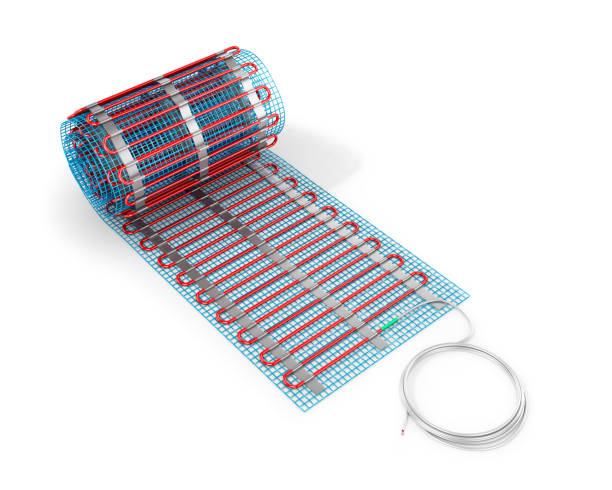With electric heating mats, you can keep your feet warm. They increase your living comfort and upgrade your house. While the installation is comparatively easy and inexpensive, high heating costs are often the result. But why is that so? How do the heating mats work, and when is it worth using them? We give you the answers here.
Contents
Structure and functionality of the electrical heating systems
Heating mats are electrical resistant and radiant heating. These consist of heating wires or heating resistors that convert electricity into heat. If there is an electrical voltage, the heating resistors heat up like a kettle. They radiate thermal energy upwards and ensure a high level of warmth.
Types of heating mats: heating carpet or underfloor heating
Heating mats are available as mobile heating carpets or permanently installed heating systems. The former is usually used in work or lounge areas. They can be plugged into the socket and put into operation quickly. Permanently installed the mats work as electrical underfloor heating. They are located in the entire room directly under the floor covering and are usually always connected to the power supply.
Particular forms: heating for greenhouses, terrariums, and aquariums
Heating mats are not only trendy in living areas. They are also used in greenhouses to provide them with heat in winter and to raise seedlings. Heating carpets, mats, or plates are also of interest for aquariums and terrariums and caravan or waterbed heating.

Operate and control the heating mats with a thermostat
The more current flows through an electric heating mat, the more it heats up. It gives off more heat and ensures higher temperatures in the room. It is operated simply via a thermostat. In heated carpets, this is usually built into the connection line to set the surface temperature.
If the under-floor heating system is used, the thermostat is located in a representative place in the room. The component is connected to a sensor on the floor and several mats and is individually adjustable. Depending on the model selected, you can choose different heating levels, room temperatures, or even time-dependent heating programs to limit the performance of the heating mats.
Can heating mats work without sensors and controllers?
Decentralized heating carpets are sometimes available without a thermostat. They have an on / off switch or heat up to a temperature specified by the manufacturer immediately after being plugged in. However, you can vary the performance of most products currently available for sale in at least three stages.
Permanently installed heating mats, such as under-floor heating, must not be operated without a sensor and controller over the long term. Overheating cannot be prevented in this way, and the systems consume significantly more energy than necessary.
By the way: if the electric heater only has an on / off switch, you can retrofit a room controller. It is inserted socket and the connection plug and releases the electricity when the room temperature is within a specific range.
Different areas of application: Not all are recommended.
Heating carpets and mats can be installed in every house – regardless of whether it is a central or decentralized system. The products are unsuitable for stand-alone heating in old buildings that have not been renovated. Because here they use so much electricity that heating costs usually rise sharply. But where can heat mats be used? The following overview shows areas in which the technology is worthwhile:
. Decentralized underfloor heating: As carpet heating under the desk, the technology ensures warm feet and a high level of comfort economically and comfortably;
. Additional electrical heating: If the electrical heating supplements a conventional system as other heating, it only ensures warm floors. it increases comfort in bathrooms without putting too much pressure on heating costs.
. Stand-alone heating in energy-saving houses: Houses built or refurbished to save energy lose almost no heat. These are equipped with an extensive photovoltaic system, the heating mat underfloor heating scores with low acquisition, operating, and maintenance costs.
. Use as exceptional heating: The technology is also recommended as a heater for greenhouses, growing seedlings, or for terrariums and aquariums. The same applies to its use as a waterbed heater.
How many watts does my heating mat need?
The performance depends on the area of application. Products for terrariums, aquariums, and the like are available from five to ten watts. These have to provide comparatively little heat. Heating carpets have an output of 50 to 1,000 watts, whereby the size and desired surface temperatures are decisive in the selection. On the other hand, it depends on the individual heat requirement when it comes to electric underfloor heating. In old buildings, this is sometimes over 150 watts per square meter. In new buildings and after renovation, it is less than 50 watts per square meter. A heating load calculation shows which power is required here;
What materials are allowed on the mats?
With electric underfloor heating, the question of a suitable floor covering over the heating mat often arises. Tiles, PVC, and linoleum are exceptionally favorable, as these allow the heat to pass through to the room very well. Parquet, vinyl, and cork on underfloor heating are also possible, but just like carpets, they counteract the heating with a more significant insulating effect. As a result, it can take longer for the heat to reach the room.
Regardless of which material is used, it should always be approved for installation over electrical under-floor heating. Related information can be found in the manufacturer’s documents.
Current prices and costs of electric heating mats
Uncomplicated heated carpets cost between 50 and 400USD, depending on their size and function. If you are looking for a high-quality product for your work area, the selection is already large enough with a budget of 150USD.
When it comes to electric underfloor heating, the costs are higher. Here the prices are between 80 and 100 USD per square meter. Also, ancillary work such as floor insulation or laying new floor coverings can cause additional costs.







